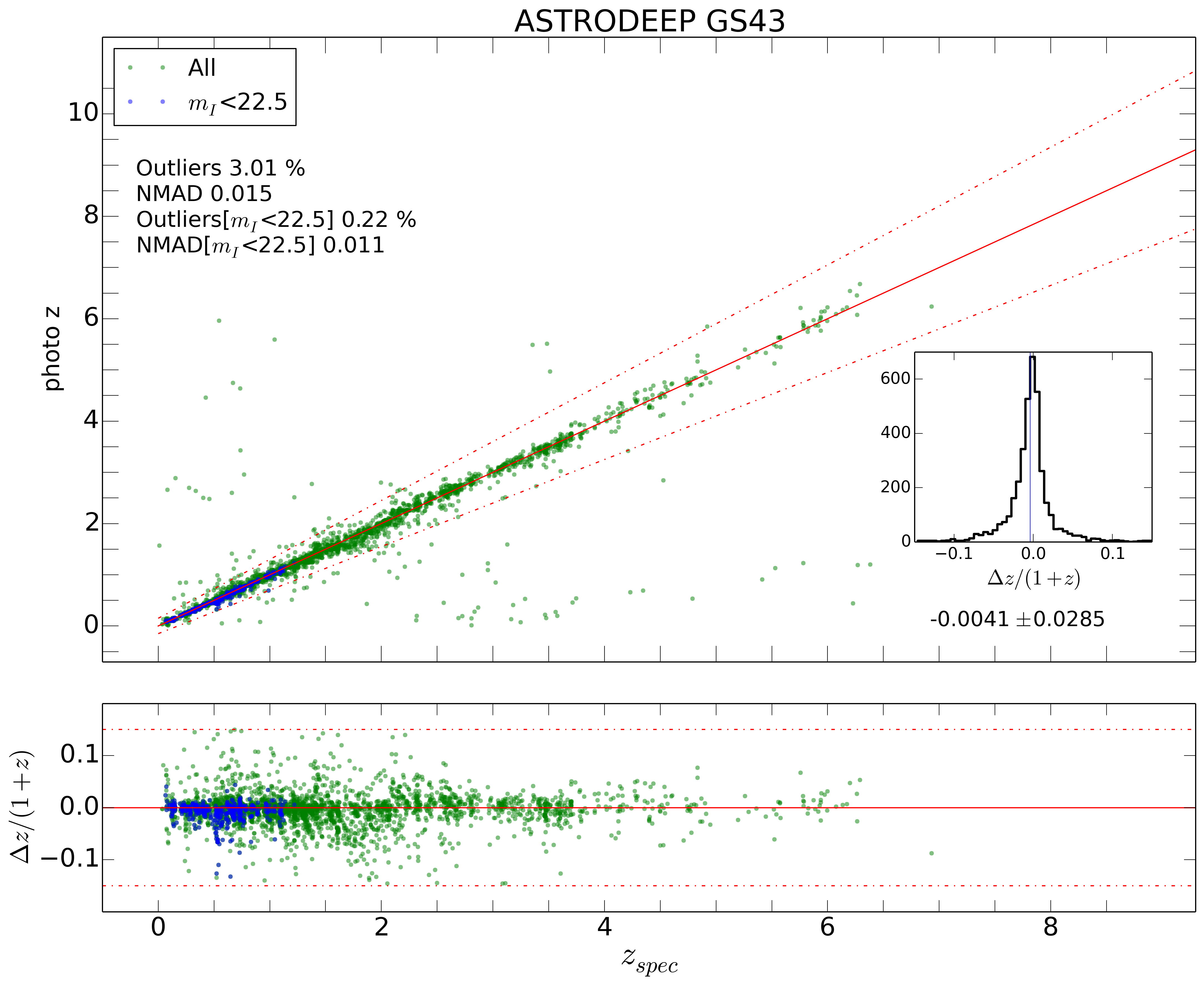We present ASTRODEEP-GS43 (Merlin et al. 2021, accepted for publication in A&A; http://arxiv.org/abs/2103.09246), a new multi-wavelength photometric catalogue of the GOODS-South field, which builds and improves upon the previously released CANDELS catalogue (Guo et al. 2013).
 We provide photometric fluxes and corresponding uncertainties in 43 optical and infrared bands (25 wide and 18 medium filters), as well as photometric redshifts and physical properties of the 34930 CANDELS H-detected objects, plus an additional sample of 173 Ks-detected and 5 IRAC-detected sources.
We provide photometric fluxes and corresponding uncertainties in 43 optical and infrared bands (25 wide and 18 medium filters), as well as photometric redshifts and physical properties of the 34930 CANDELS H-detected objects, plus an additional sample of 173 Ks-detected and 5 IRAC-detected sources.
We keep the CANDELS photometry in 7 bands (CTIO U, Hubble Space Telescope WFC3 and ISAAC-K), and measure from scratch the fluxes in the other 36 (VIMOS, HST ACS, HAWK-I Ks, Spitzer IRAC, and 23 from Subaru SuprimeCAM and Magellan-Baade Fourstar) with state-of-the-art techniques (in particular using T-PHOT v2.0 on all ground-based and Spitzer bands). We then compute new photometric redshifts as the median of three independent estimates, and new physical parameters from SED fitting, which we compare to the previously published ones.
The main improvements with respect to the previous CANDELS catalogue (Guo et al. 2013) are the following:
- we added photometric measurements on 18 Subaru SuprimeCAM medium bands (MUSYC, Cardamone et al. 2010), 5 medium bands from Magellan-Baade Fourstar (ZFOURGE, Straatman et al. 2016), and the B and R bands from VIMOS, to the previously released 18 wide bands;
- we added to the catalogue 173 new objects detected in the HUGS Ks band. Furthermore, we added 5 additional objects detected in the Spitzer IRAC CH1 and CH2 bands. Of the latter, 3 are from the list of 10 H-dropouts by Wang et al. (2016); the remaining 7 of their list are already among our Ks-detections. The final additional 2 sources were again found by Wang and collaborators (priv. comm.), but they were excluded from their published list because of the presence of close contaminants;
- we measured ACS-HST fluxes from the new, deep mosaics released by the Hubble Legacy Fields project (Illingworth et al. 2016, Whitaker et al. 2019), using SExtractor to estimate aperture PSF-matched photometry;
- we used T-PHOT v2.0 to process from scratch the new images of ground-based medium bands and Spitzer bands, using three substantial algorithmic improvements: (i) the prioring from the closest-wavelength high-resolution band for the medium bands; (ii) the background subtraction during the fitting process and (iii) individual locally variable PSFs for IRAC (these techniques are described in details in Merlin et al. 2016);
- the IRAC bands CH1 and CH2 photometry is estimated on mosaics created by R. McLure which reach an average depth of 25.6 AB (total mag in 5σ), so that we gain a substantial amount of detections previously catalogued as upper limits.
Comparing to a sample of 3930 spectroscopic redshifts, for the new photo-z’s we obtain a normalized median absolute deviation (NMAD) of 0.0147 with 3.01% of severe outliers on the full catalogue (0.0109, 0.22% on the bright end I814<22.5), similar to the best available published samples of photometric redshifts such as the COSMOS UltraVISTA catalogue (Ilbert et al. 2013).

We release two separate files. The first one, named ASTRODEEP-GS43_phot.cat, includes the 43 bands photometry; the passbands are listed in order of increasing wavelength, and we provide total fluxes and corresponding uncertainties in μJy. The second one, ASTRODEEP-GS43_phys.cat, includes the redshift estimation (the spectroscopic z when available, including the original reference; and the best photometric z otherwise) and two physical parameters, namely stellar mass and instantaneous SFR, with 1σ uncertainties, for two SFH models.
If you use this catalogue, please cite Merlin et al. 2021 (accepted for publication in A&A; http://arxiv.org/abs/2103.09246)
For any issue/problem/suggestion please contact emiliano.merlin@inaf.it
